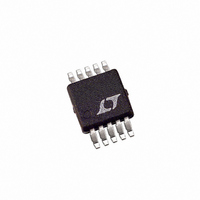LT3757EMSE#PBF Linear Technology, LT3757EMSE#PBF Datasheet - Page 21

LT3757EMSE#PBF
Manufacturer Part Number
LT3757EMSE#PBF
Description
IC CTRLR DC/DC ADJ 10-MSOP
Manufacturer
Linear Technology
Type
Step-Up (Boost), Inverting, Flyback, Sepicr
Datasheet
1.LT3757EDDPBF.pdf
(36 pages)
Specifications of LT3757EMSE#PBF
Internal Switch(s)
No
Synchronous Rectifier
No
Number Of Outputs
1
Frequency - Switching
100kHz ~ 1MHz
Voltage - Input
2.9 ~ 40 V
Operating Temperature
-40°C ~ 125°C
Mounting Type
Surface Mount
Package / Case
10-MSOP Exposed Pad, 10-HMSOP, 10-eMSOP
Lead Free Status / RoHS Status
Lead free / RoHS Compliant
Current - Output
-
Voltage - Output
-
Power - Output
-
Available stocks
Company
Part Number
Manufacturer
Quantity
Price
applicaTions inForMaTion
Flyback Converter: Output Diode Selection
The output diode in a flyback converter is subject to large
RMS current and peak reverse voltage stresses. A fast
switching diode with a low forward drop and a low reverse
leakage is desired. Schottky diodes are recommended if
the output voltage is below 100V.
Approximate the required peak repetitive reverse voltage
rating V
The power dissipated by the diode is:
P
and the diode junction temperature is:
T
The R
the R
the board to the ambient temperature in the enclosure. T
must not exceed the diode maximum junction temperature
rating.
Flyback Converter: Output Capacitor Selection
The output capacitor of the flyback converter has a similar
operation condition as that of the boost converter. Refer to
the Boost Converter: Output Capacitor Selection section
for the calculation of C
The RMS ripple current rating of the output capacitors
in discontinuous operation can be determined using the
following equation:
I
V
RMS COUT DISCONTINUOUS
J
D
RRM
= T
= I
θJC
θJA
(
RRM
for the device, plus the thermal resistance from
O(MAX)
A
>
to be used in this equation normally includes
+ P
N
N
using:
P
S
),
D
•
• R
• V
V
IN MAX
D
θJA
(
OUT
)
+
and ESR
V
OUT
≥
I
O MAX
(
COUT
)
.
•
4
−
3 D D 2
( •
3
•
D
2
)
J
Flyback Converter: Input Capacitor Selection
The input capacitor in a flyback converter is subject to
a large RMS current due to the discontinuous primary
current. To prevent large voltage transients, use a low
ESR input capacitor sized for the maximum RMS current.
The RMS ripple current rating of the input capacitors in
discontinuous operation can be determined using the
following equation:
SEPIC CONVERTER APPLICATIONS
The LT3757 can be configured as a SEPIC (single-ended
primary inductance converter), as shown in Figure 1. This
topology allows for the input to be higher, equal, or lower
than the desired output voltage. The conversion ratio as
a function of duty cycle is:
in continuous conduction mode (CCM).
In a SEPIC converter, no DC path exists between the input
and output. This is an advantage over the boost converter
for applications requiring the output to be disconnected
from the input source when the circuit is in shutdown.
Compared to the flyback converter, the SEPIC converter
has the advantage that both the power MOSFET and the
output diode voltages are clamped by the capacitors (C
C
across the power MOSFET and the output diodes. The
SEPIC converter requires much smaller input capacitors
than those of the flyback converter. This is due to the fact
DC
I
V
RMS CIN DISCONTINUOUS
and C
OUT
V
(
IN
+
),
V
OUT
D
=
), therefore, there is less voltage ringing
− 1
D
D
≥
V
P
IN MIN
OUT MAX
(
(
)
•
h
)
• •
4
LT3757
−
3
( •
3
•
D
MAX
D
MAX
3757fb
)
IN
,














